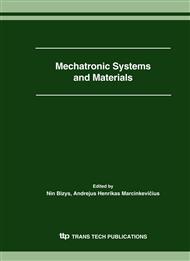p.1
p.7
p.13
p.19
p.25
p.29
p.34
p.39
p.45
A Computer Control System for the Hydraulic Stand MZPK 100 for Biaxial Fatigue Testing
Abstract:
This paper presents a two-channel digital control system for the hydraulic stand MZPK 100 designed for fatigue tests of cruciform specimens under biaxial tension-compression. In the past, the fatigue test stand MZPK 100 was provided with unreliable analog control power cubicles. Application of the computer with an analog and digital input-output signal path board, Matlab/Simulink software and a new control box equipped with the necessary electronic subassemblies (responsible for proper switching of the hydraulic supplier, command electrovalves, conditioning of signals from sensors and so on) enables replacement of the old analog system by a new two-channel digital control system. Nowadays, it is easy to modify the control system to different requirements of material tests because the hardware (electronic) solutions have been simplified, and the software has a friendly Simulink interface. Such an approach allows for the implementation of different control algorithms, e.g. PID, adaptive, and fuzzy logic etc. Moreover, this paper presents a description of how to keep the center of the specimen static under a controlled force that is being applied by four independent actuators.
Info:
Periodical:
Pages:
13-18
Citation:
Online since:
June 2006
Authors:
Price:
Сopyright:
© 2006 Trans Tech Publications Ltd. All Rights Reserved
Share:
Citation:


